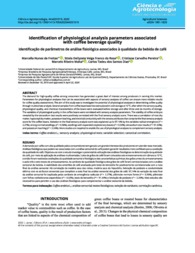Identification of physiological analysis parameters associated with coffee beverage quality.
Identification of physiological analysis parameters associated with coffee beverage quality.
Author(s): FREITAS, M. N. de; ROSA, S. D. V. F. da; PEREIRA, C. C.; MALTA, M. R.; DIAS, C. T. dos S.
Summary: The demand for high-quality coffee among consumers has generated a great deal of interest among producers in serving this market. Parameters for physiological analyses that can be associated with aspects of sensory analyses of coffee can ensure more reliable results for coffee quality assessments. The aim of this study was to investigate the potential of physiological analyses in determining coffee quality through multivariate analysis. Several samples from coffee bean/seed lots were placed in cold storage at 10 °C, after which the sensory quality, physiological quality, and chemical characteristics of the beans were evaluated before storage and after three and six months of storage. The variables of physiological quality in the coffee beans were correlated with sensory analysis parameters. The viability of coffee embryos revealed by the tetrazolium test results were positively correlated with the final sensory analysis score. There was a correlation of root dry matter, hypocotyl dry matter, potassium leaching, and electrical conductivity with the sensory attributes that comprise the final sensory analysis score for the coffee beans. Variation in the final sensory analysis score was explained up to 97.14% by the variables radical emergence (r2 = 2.27%), strong normal seedlings, (r2 = 0.56%), seedlings with expanded cotyledonary leaves (r2 = 0.53%), tetrazolium test results (r2 = 91.54%), and potassium leaching (r2 = 2.24%). More studies are required to enable the use of physiological analyses to complement sensory analysis.
Publication year: 2020
Types of publication: Journal article
Unit: Embrapa Coffee
Keywords: Análise Qualitativa, Café, Coffea arabica var. arabica, Fisiologia, Seed quality
Observation
Some of Embrapa's publications are published as ePub files. To read them, use or download one of the following free software options to your computer or mobile device. Android: Google Play Books; IOS: iBooks; Windows and Linux: Calibre.
Access other publications
Access the Agricultural Research Database (BDPA) to consult Embrapa's full library collection and records.
Visit Embrapa Bookstore to purchase books and other publications sold by Embrapa.

